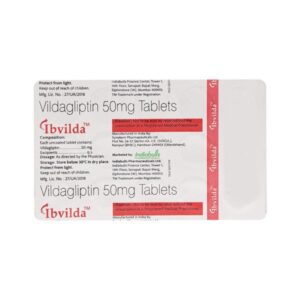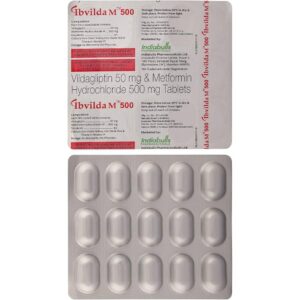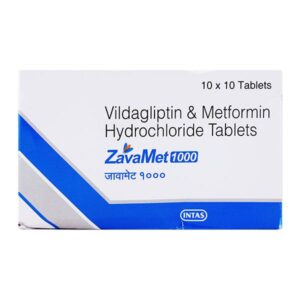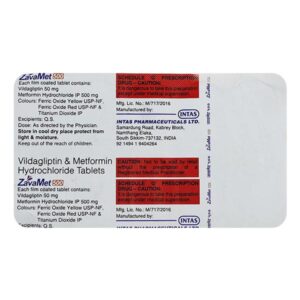METFORMIN + VIDAGLIPTIN
Metformin: Metformin is a commonly prescribed medication used to treat type 2 diabetes. It belongs to the class of drugs called biguanides. It is available as a generic version and under various brand names, such as Glucophage.
The primary use of metformin is to control blood sugar levels in people with type 2 diabetes. It works by reducing the amount of glucose produced by the liver and improving the body’s sensitivity to insulin. It does not increase insulin production from the pancreas.
The typical starting dose of metformin is usually 500 mg or 850 mg once daily or twice daily, with meals. The dosage can be adjusted based on the individual’s response and blood glucose levels. The maximum recommended daily dose is usually 2,000 mg, divided into two or three doses.
Like any medication, metformin can cause side effects. The most common side effects include gastrointestinal issues, such as nausea, diarrhea, abdominal discomfort, and a metallic taste in the mouth. These side effects usually occur at the beginning of treatment and tend to decrease over time. It is recommended to take metformin with food to help reduce these gastrointestinal effects.
In rare cases, metformin can cause more serious side effects, such as lactic acidosis, which is a potentially life-threatening condition. Lactic acidosis is more likely to occur in individuals with kidney or liver problems, or those with conditions that may cause reduced oxygen levels in the body, such as heart failure or severe infections.
Additionally, metformin may have some benefits beyond diabetes treatment. It is sometimes prescribed off-label for conditions such as polycystic ovary syndrome (PCOS) and gestational diabetes.
It is important to note that metformin should not be used in individuals with significant kidney problems, liver disease, or in those who are allergic to metformin. As with any medication, it is crucial to discuss your medical history and any potential contraindications with your healthcare provider before starting metformin.
Vidagliptin: Vidagliptin, also known as Vildagliptin, is a prescription medication used to treat type 2 diabetes mellitus. It is marketed under the brand name Galvus.
Mechanism of Action: Vidagliptin is a dipeptidyl peptidase-4 (DPP-4) inhibitor. It works by inhibiting the enzyme DPP-4, which in turn increases the levels of incretin hormones like glucagon-like peptide-1 (GLP-1) and glucose-dependent insulinotropic polypeptide (GIP). These hormones play a role in regulating blood sugar levels by increasing insulin secretion and decreasing glucagon release from the pancreas. By inhibiting DPP-4, Vidagliptin helps lower blood sugar levels in individuals with type 2 diabetes.
Dose: The usual recommended dose of Vidagliptin is 50 mg taken orally once daily. However, the dosage may vary depending on individual patient factors, such as renal function and other coexisting medical conditions. It is important to follow the prescribed dose as instructed by a healthcare professional.
Side Effects: Common side effects of Vidagliptin may include headache, dizziness, upper respiratory tract infections, nasopharyngitis, urinary tract infections, and gastrointestinal symptoms like nausea, diarrhea, and abdominal pain. In rare cases, allergic reactions such as rash, itching, and swelling may occur. It is advisable to seek medical attention if any severe or persistent side effects are experienced.
As with any medication, it is essential to discuss potential risks and benefits with a healthcare professional before starting Vidagliptin. They can provide personalized guidance and monitor for any potential drug interactions or contraindications.





